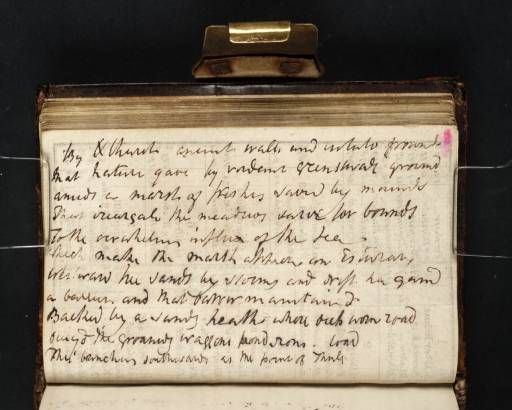Joseph Mallord William Turner Inscription by Turner: Draft of Poetry 1811
Joseph Mallord William Turner,
Inscription by Turner: Draft of Poetry
1811
Joseph Mallord William Turner 1775–1851
Folio 50 Verso:
Inscription by Turner: Draft of Poetry 1811
D08458
Turner Bequest CXXIII 50a
Turner Bequest CXXIII 50a
Inscribed by Turner in ink (see main catalogue entry) on white wove printing paper, 75 x 117 mm
Accepted by the nation as part of the Turner Bequest 1856
References
1862
Walter Thornbury, The Life of J.M.W. Turner, R.A. Founded on Letters and Papers Furnished by his Friends and Fellow-Academicians, London 1862, vol.II, p.20.
1897
Walter Thornbury, The Life of J.M.W. Turner, R.A. Founded on Letters and Papers Furnished by his Friends and Fellow-Academicians: A New Edition, Revised with 8 Coloured Illustrations after Turner’s Originals and 2 Woodcuts, London 1897, p.209.
1909
A.J. Finberg, A Complete Inventory of the Drawings of the Turner Bequest, London 1909, vol.I, p.346, CXXIII 50a, as ‘Verses’.
1966
Jack Lindsay, The Sunset Ship: The Poems of J.M.W. Turner, Lowestoft 1966, pp.111–12.
1980
John Gage, Collected Correspondence of J.M.W. Turner with an Early Diary and a Memoir by George Jones, Oxford 1980, p.55 under letter no.48 note 2, as ‘CXXIII, p.52a’.
1981
Eric Shanes, Turner’s Rivers, Harbours and Coasts, London 1981, p.[22] under no.19.
1990
Eric Shanes, Turner’s England 1810–38, London 1990, pp.42 under no.19, 283 note 20.
1990
Andrew Wilton and Rosalind Mallord Turner, Painting and Poetry: Turner’s ‘Verse Book’ and his Work of 1804–1812, exhibition catalogue, Tate Gallery, London 1990, p.171.
1992
Howard J.M. Hanley, Turner in Dorset: Images from the Picturesque Views on the Southern Coast of England, exhibition catalogue, Mulberry Gallery, Weymouth Library 1992, p.3.
The whole page is taken up with the following lines of verse:
By <C> Church ancient walls and [?isolate] frownd
That nature gave by verdant greensward ground
Amids a marsh of [?rushes] saved by mounds
That [?irrugate] the meadows serve for bounds
To the overwhelming influx of the Sea
Which make the marsh appear an Esturary
Westward the sands by storms and drift hav gaind
a barrier and that barrier maintained
Backed by a sandy heath whose deep worn road
[‘buryd’ or ‘Denyd’] the groaning waggons pondrous load
This branching southwards as the point of Thule1
That nature gave by verdant greensward ground
Amids a marsh of [?rushes] saved by mounds
That [?irrugate] the meadows serve for bounds
To the overwhelming influx of the Sea
Which make the marsh appear an Esturary
Westward the sands by storms and drift hav gaind
a barrier and that barrier maintained
Backed by a sandy heath whose deep worn road
[‘buryd’ or ‘Denyd’] the groaning waggons pondrous load
This branching southwards as the point of Thule1
Interspersed with drawings and the printed pages of Coltman’s British Itinerary, sixty-nine pages of this sketchbook are given over wholly or partly to these verses which Turner intended as a commentary for publication with the Picturesque Views on the Southern Coast of England which he sketched on the 1811 West Country tour (see the introduction to the sketchbook). The first lines are on folio 18 verso (D08396), and the last on folio 207 verso (D08736; CXXIII 204a).
The previous passage is on folio 48 verso (D08454), concluding the story of a lobster-catcher and his wife; the first two lines here may be the tail-end of that narrative. Here the geographical thread is picked up again, with a description of Poole Harbour, Dorset, the town of Poole being identified at the end of the first line of the next passage, on folio 53 verso (D08464; CXXIII 52a), rhyming with ‘Thule’ here, a rather wayward use of the term, traditionally indicating a semi-mythical land to the far North of the known world.
Turner sketched Poole Harbour on folios 14 recto and 16 recto (D08387, D08391) and made a watercolour in about 1812 (private collection),2 engraved in 1814 for the Southern Coast of England as Poole, Dorsetshire; as John Gage notes, the waggon’s load ‘appears in the plate’.3 Lindsay and Shanes have given the first word of the penultimate line as ‘Denyd’, while Wilton and Turner read it as ‘buryd’.
Matthew Imms
June 2011
See transcriptions (followed here with slight variations) in Lindsay 1966, pp.111–12, second half of line three onwards as part of ‘Poole Harbour’, section (h) of poem no.50, ‘On the Western Itinerary 1811’, and Wilton and Turner 1990, p.171; previously transcribed with variations in Thornbury 1862, II, p.20 and 1897, p.209; line seven onwards transcribed with slight variations in Shanes 1981, p.[22] (see also Shanes 1990, p.42), and in Hanley 1992, p.3.
How to cite
Matthew Imms, ‘Inscription by Turner: Draft of Poetry 1811 by Joseph Mallord William Turner’, catalogue entry, June 2011, in David Blayney Brown (ed.), J.M.W. Turner: Sketchbooks, Drawings and Watercolours, Tate Research Publication, December 2012, https://www

